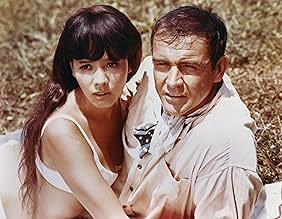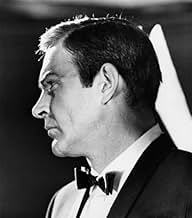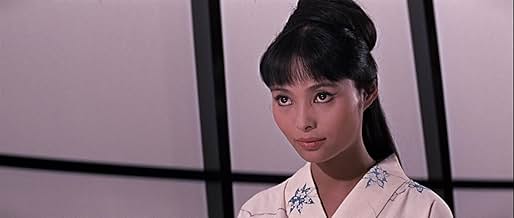James Bond and the Japanese Secret Service must find and stop the true culprit of a series of space hijackings, before war is provoked between Russia and the United States.James Bond and the Japanese Secret Service must find and stop the true culprit of a series of space hijackings, before war is provoked between Russia and the United States.James Bond and the Japanese Secret Service must find and stop the true culprit of a series of space hijackings, before war is provoked between Russia and the United States.
- Nominated for 1 BAFTA Award
- 2 wins & 3 nominations total
Tetsurô Tanba
- Tiger Tanaka
- (as Tetsuro Tamba)
Storyline
Did you know
- TriviaWhile scouting locations in Japan, the chief production team narrowly escaped death. On March 5, 1966, producers Albert R. Broccoli and Harry Saltzman, director Lewis Gilbert, cinematographer Freddie Young, and production designer Sir Ken Adam were booked to leave Japan on BOAC flight 911 departing Tokyo for Hong Kong and London. Two hours before their Boeing 707 flight departed, the team was invited to an unexpected ninja demonstration, and so missed their plane. Their flight took off as scheduled, and twenty-five minutes after take-off, the plane encountered severe turbulence and disintegrated over Mt. Fuji, killing all aboard.
- GoofsAfter a four-hour hike to the top of the crater with no backpack, Bond pulls out a full suction cup apparatus set-up. How did he ever know to bring this, not knowing there was anything inside the crater?
- Quotes
Tiger Tanaka: It can save your life, this cigarette.
James Bond: You sound like a commercial.
- Crazy creditsTHE END of YOU ONLY LIVE TWICE but James Bond will be back ON HER MAJESTY'S SECRET SERVICE
- Alternate versionsThe Ultimate Edition reinserts some additional brief scenes that were omitted from early video versions and English broadcasts. Missing brief scenes were:
- 1) Tiger shows Bond the rocket guns.
- 2) A ninja cuts the arms off the 'hay man'.
- 3) A ninja throws shooting stars.
- 4) An assassin attempts to kill Bond by a spike out of the pole.
- 5) Tiger's throw of the stars at Blofeld's arm is longer.
- ConnectionsEdited into The Spy Who Loved Me (1977)
Featured review
Solid entry in the James Bond saga – Sean Connery's fifth appearance as the secret agent in a row (his last, in fact, until DIAMONDS ARE FOREVER [1971] and, eventually, the non-series entry NEVER SAY NEVER AGAIN [1983]) – featuring a lovely title tune by John Barry and Leslie Bricusse sung by Nancy Sinatra.
The relocation to Japan for the main action (resulting in impeccable photography courtesy of the renowned Freddie Young, who also contributes an inspired aerial shot of our hero at the center of a rooftop chase/struggle) adds much-needed novelty in the exotic department – though characters tend to be less well developed as a consequence. Tetsuro Tamba is imposing enough as his 'sidekick', but the all-important Bond girls have no distinguishing features – save for Karin Dor, a typical femme-fatale-ish villainess who manages to trap Bond in an unpiloted plane. Similar expansiveness was shown in Ken Adam's elaborate design of Ernst Stavro Blofeld's headquarters, hidden within the crater of a Japanese volcano; other attention-grabbing devices include Bond being 'killed' in the prologue (thus explaining the title), while he's later given an Oriental 'countenance' and even made to 'marry' a Japanese girl (an irrelevant undercover attempt, as it happens – since there is very little interaction between Bond, his local allies and the enemy before the final confrontation in the volcano interior)!
Its plot involving the abduction of space shuttles belonging to the U.S. and Russia, in the hope of provoking a war between the major powers, again plays on the fears of nuclear annihilation palpable during the Cold War era. Incidentally, this is the first time Blofeld himself steps in as chief villain (played with appropriate menace by Donald Pleasence – with a handy piranha-filled stream underneath a sliding bridge to replace the pool-sharks from the previous installment, THUNDERBALL [1965]). By the way, Charles Gray (Blofeld in DIAMONDS ARE FOREVER) appears in a bit here as Bond's ill-fated contact in Japan! The most prominent gadget invented by Q (the ubiquitous Desmond Llewellyn) in this case is an artillery-equipped mini-chopper – employed in a sequence whose filming unfortunately cost an aerial photographer his leg!; there's also a memorably violent brawl which has Bond and his opponent lashing at each other with heavy living-room couches!
The show, then, is climaxed by one of the most spectacular action bouts in the entire saga – for which Bond recruits Tamba's ninjas to fight the minions of SPECTRE; Blofeld, of course, is allowed to go free this time around since he'd be involved in at least three subsequent direct matches with 007. Given that director Gilbert lived up to the challenge of ably following in the footsteps of Terence Young and Guy Hamilton, it was only natural he'd be asked to helm further Bond adventures – though, by the time THE SPY WHO LOVED ME (1977) and MOONRAKER (1979) came along, Roger Moore had firmly established himself in the role.
The relocation to Japan for the main action (resulting in impeccable photography courtesy of the renowned Freddie Young, who also contributes an inspired aerial shot of our hero at the center of a rooftop chase/struggle) adds much-needed novelty in the exotic department – though characters tend to be less well developed as a consequence. Tetsuro Tamba is imposing enough as his 'sidekick', but the all-important Bond girls have no distinguishing features – save for Karin Dor, a typical femme-fatale-ish villainess who manages to trap Bond in an unpiloted plane. Similar expansiveness was shown in Ken Adam's elaborate design of Ernst Stavro Blofeld's headquarters, hidden within the crater of a Japanese volcano; other attention-grabbing devices include Bond being 'killed' in the prologue (thus explaining the title), while he's later given an Oriental 'countenance' and even made to 'marry' a Japanese girl (an irrelevant undercover attempt, as it happens – since there is very little interaction between Bond, his local allies and the enemy before the final confrontation in the volcano interior)!
Its plot involving the abduction of space shuttles belonging to the U.S. and Russia, in the hope of provoking a war between the major powers, again plays on the fears of nuclear annihilation palpable during the Cold War era. Incidentally, this is the first time Blofeld himself steps in as chief villain (played with appropriate menace by Donald Pleasence – with a handy piranha-filled stream underneath a sliding bridge to replace the pool-sharks from the previous installment, THUNDERBALL [1965]). By the way, Charles Gray (Blofeld in DIAMONDS ARE FOREVER) appears in a bit here as Bond's ill-fated contact in Japan! The most prominent gadget invented by Q (the ubiquitous Desmond Llewellyn) in this case is an artillery-equipped mini-chopper – employed in a sequence whose filming unfortunately cost an aerial photographer his leg!; there's also a memorably violent brawl which has Bond and his opponent lashing at each other with heavy living-room couches!
The show, then, is climaxed by one of the most spectacular action bouts in the entire saga – for which Bond recruits Tamba's ninjas to fight the minions of SPECTRE; Blofeld, of course, is allowed to go free this time around since he'd be involved in at least three subsequent direct matches with 007. Given that director Gilbert lived up to the challenge of ably following in the footsteps of Terence Young and Guy Hamilton, it was only natural he'd be asked to helm further Bond adventures – though, by the time THE SPY WHO LOVED ME (1977) and MOONRAKER (1979) came along, Roger Moore had firmly established himself in the role.
- Bunuel1976
- Nov 23, 2008
- Permalink
- How long is You Only Live Twice?Powered by Alexa
Details
- Release date
- Countries of origin
- Official site
- Languages
- Also known as
- Ian Fleming's You Only Live Twice
- Filming locations
- Mount Shinmu-dake, Kirishima-Yaku National Park, Kagoshima, Japan(exteriors: Blofeld's Volcano Lair)
- Production company
- See more company credits at IMDbPro
Box office
- Budget
- $9,500,000 (estimated)
- Gross US & Canada
- $43,084,787
- Gross worldwide
- $43,115,913
- Runtime1 hour 57 minutes
- Sound mix
- Aspect ratio
- 2.39 : 1
Contribute to this page
Suggest an edit or add missing content








































